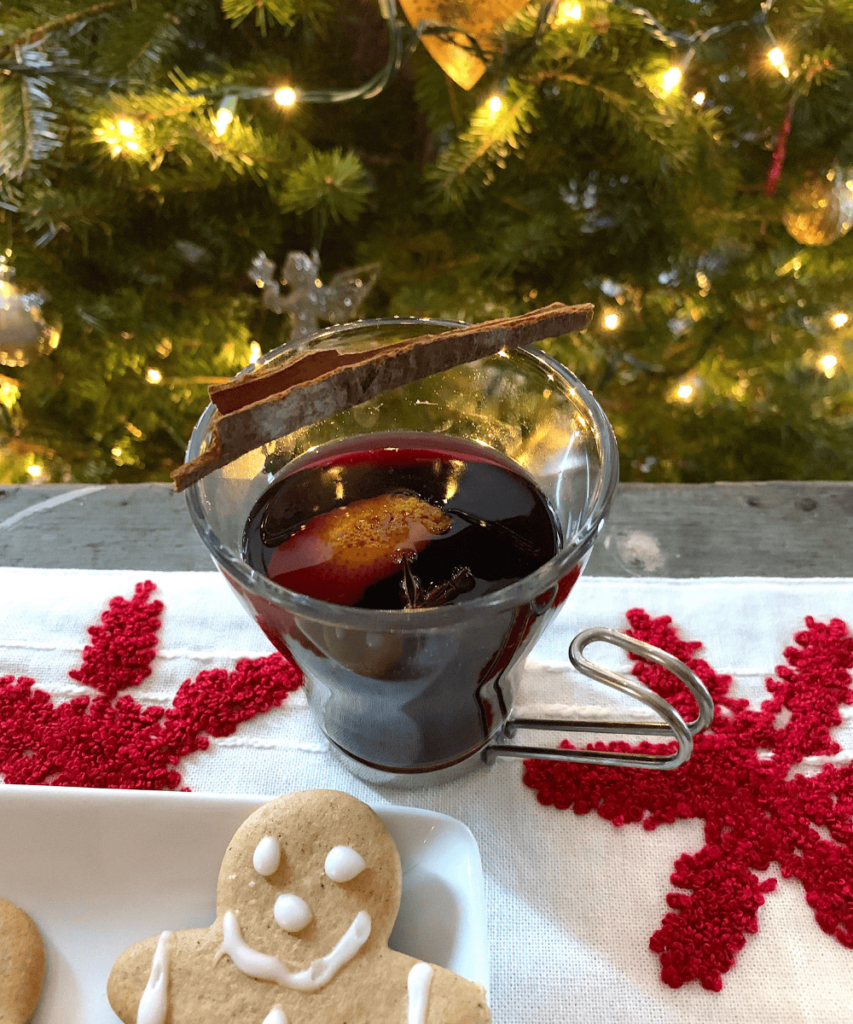No Christmas is complete without a hot, spicy cup of gløgg (mulled wine) which warms up your body all the way through to the root of your hair!
Sitting down with a glass of gløgg is wonderfully relaxing and tasty in between the stressful pre-holiday chores like cleaning, shopping, and cooking.

Mulled wine has been around in many versions around the world for centuries. The ancient Greeks and Romans were thought to drink sweet and spicy wine, and in the 16th-century people would start serving the wine hot with cognac added to it.
The Germans enjoyed mulled wine as early back as in the 15th century, supposedly in a castle along the Rhine river, where they thought to heat up red wine and add a variety of spices to keep warm during the cold winter months. It was first in the late 20th century that gløgg became a Christmas tradition, and then still only in Germany and other Germanic countries (glühwein) before it spread to northern Europe.
The term gløgg was invented in Sweden right after the Second World War and stems from the words “glödgat vin”, which means heated wine.
Today it is enjoyed throughout Sweden, Norway, and Denmark. What separates Norwegian gløgg from other types of mulled wine, is that we use a lot more spices than other countries do.
There are a million different recipes and varieties but most of them include red wine, some type of sweetener like sugar, brown sugar, honey or maple syrup, cardamom, cloves, ginger, and citrus peel from oranges or lemons.
Today, people and bartenders are experiencing with other additions like dried blueberries and blackberries, apricots, and black pepper.
Classic garnishes include almonds and raisins, and gløgg is enjoyed with a variety of Christmas cookies like gingersnaps and krumkaker.
There is no need to use an expensive red wine to make gløgg, however, I wouldn’t recommend a terrible wine either, as the flavors typically are heightened when the wine is heated up.
Never heat up the wine until it boils, because the alcohol will evaporate (and what fun would that be?). As soon as you see some steam at the top, quickly turn it off, place a lid on the pot, and let the spices steep for a couple of hours to let the flavors blend into the wine.
When you’re ready to serve, heat it up again, and alternatively you can add a little port wine, cognac, aquavit, or vodka to each glass before lading in the mulled wine.
If you don’t drink alcohol, choose a non-alcoholic version of gløgg by heating up blackcurrant juice, fresh-pressed orange juice, or apple cider (or a combination of all), and add the spices and sweeteners the same way as with the alcoholic version.
As a prior bartender, mixologist, and Certified Specialist of Spirits, I take pride in my own recipe for gløgg and have become quite known for it.
Try it and remember: Drink responsibly!

SYNNØVE’S CHRISTMAS GLØGG
1 x 750ml bottled of full-bodied red wine (like Zinfandel, Garnacha or Merlot)
1/2 cup brown sugar
2 small or 1 large cinnamon stick
2 star anise pods
1 tsp green cardamom pods
5-6 whole cloves
1 allspice berry
1 x 3-inch piece of ginger, peeled and sliced thin
2 strips of orange peel, pith/white removed
1/2 cup ruby port wine
splash of aquavit or brandy
Handful of toasted almonds (optional)
Handful of raisins (optional)
Combine all the ingredients except aquavit/brandy, in a medium saucepot and heat up until just under boiling and steam starts to rise from the wine. Quickly turn off the heat, place a lid on the pot and let spices steep for 2 hours or longer.
When ready to serve, add 1-2 oz of aquavit or brandy to a nice glass, strain the mulled wine and ladle in warm mulled wine.
Garnish with an orange peel and almonds and raisins (optional).
Serve with your favorite Christmas cookies or Christmas tapas!




0 Comments